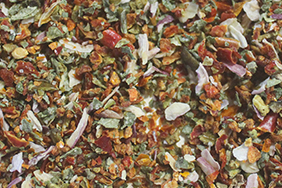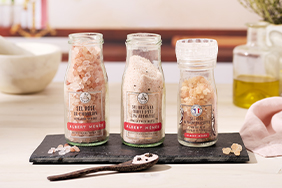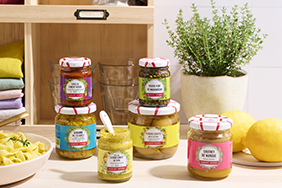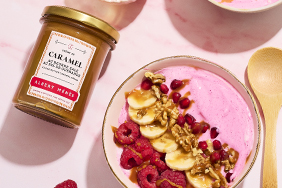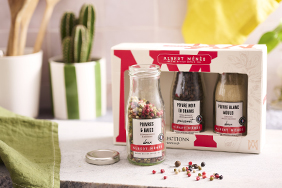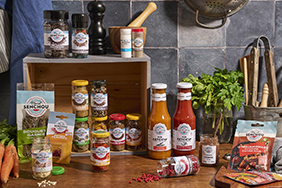-
MenuBack
-
SPICES IN A BAG
-
-
Our spices in a bag
-
-
-
Our spices in a bag
-
-
-
Texte 2
Add a touch of the Mediterranean with this blend, ideal as a sauce or at the end of cooking.
-
-
Texte 2
More than 50 large-format products in an economical and practical kraft bag.
-
-
Spices
-
-
-
Catégories
-
-
-
Texte 2
Une alliance parfaite entre l'ail et le piment qui donnera vie à vos plats avec une intensité envoûtante.
-
-
salts
Our exceptional Albert Ménès salts are real little jewels with bright colours and original flavours.
-
-
Deli
-
-
-
-
Texte 2
Let yourself be tempted by our quality seafood, carefully selected for you.
-
-
Texte 2
A real alternative to traditional spices, these accompaniments will enhance the flavour of your favourite dishes.
-
- Jams and Honeys
- Gifts
- House
- Our recipes
- Contact us
-
MenuBack
-
SPICES IN A BAG
-
-
Our spices in a bag
-
-
-
Our spices in a bag
-
-
-
Texte 2
Add a touch of the Mediterranean with this blend, ideal as a sauce or at the end of cooking.
-
-
Texte 2
More than 50 large-format products in an economical and practical kraft bag.
-
-
Spices
-
-
-
Catégories
-
-
-
Texte 2
Une alliance parfaite entre l'ail et le piment qui donnera vie à vos plats avec une intensité envoûtante.
-
-
salts
Our exceptional Albert Ménès salts are real little jewels with bright colours and original flavours.
-
-
Deli
-
-
-
-
Texte 2
Let yourself be tempted by our quality seafood, carefully selected for you.
-
-
Texte 2
A real alternative to traditional spices, these accompaniments will enhance the flavour of your favourite dishes.
-
- Jams and Honeys
- Gifts
- House
- Our recipes
- Contact us
Découvrez toutes nos recettes
Search in blog
Blog categories
Popular posts
-
 Poulet basquaise : the real traditional recipe28/02/2023Posted in: Recipes128349 viewsBasque chicken: a traditional and easy recipe with the flavours of the South-WestRead more
Poulet basquaise : the real traditional recipe28/02/2023Posted in: Recipes128349 viewsBasque chicken: a traditional and easy recipe with the flavours of the South-WestRead more -
 North African Couscous recipe: the real traditional quick and easy recipe!02/05/2021Posted in: Recipes124055 viewsThe real recipe for North African couscous An easy-to-make recipe that's impossible to beat!Read more
North African Couscous recipe: the real traditional quick and easy recipe!02/05/2021Posted in: Recipes124055 viewsThe real recipe for North African couscous An easy-to-make recipe that's impossible to beat!Read more -
 Tunisian Chakchouka18/10/2022Posted in: Recipes24610 viewsTunisian chakchouka with eggsRead more
Tunisian Chakchouka18/10/2022Posted in: Recipes24610 viewsTunisian chakchouka with eggsRead more -

-
 Tunisian couscous from the sea18/10/2022Posted in: Recipes16811 viewsTunisian white fish couscous with smoked organic Provence pepper harissa.Read more
Tunisian couscous from the sea18/10/2022Posted in: Recipes16811 viewsTunisian white fish couscous with smoked organic Provence pepper harissa.Read more
Featured posts
-
 Boulettes de quinoa à l'indienneDécouvrez cette recette de boulettes de quinoa aux saveurs indiennes avec une touche de curry et de safranRead more
Boulettes de quinoa à l'indienneDécouvrez cette recette de boulettes de quinoa aux saveurs indiennes avec une touche de curry et de safranRead more -
 Spritz revisité au mélange vin chaud207 viewsRéinventez le Spritz avec cette version chaude et notre mélange vin chaud, un régal pour se réchauffer cet hiverRead more
Spritz revisité au mélange vin chaud207 viewsRéinventez le Spritz avec cette version chaude et notre mélange vin chaud, un régal pour se réchauffer cet hiverRead more -
 Savoyard fondue12/02/2025Posted in: Recipes3708 viewsTreat your guests to this traditional, hearty dish. This blend of Savoy cheeses, spiced up with our garlic confit,...Read more
Savoyard fondue12/02/2025Posted in: Recipes3708 viewsTreat your guests to this traditional, hearty dish. This blend of Savoy cheeses, spiced up with our garlic confit,...Read more -
 Rice pudding with cinnamon12/02/2025Posted in: Recipes250 viewsThis recipe for rice pudding will delight your taste buds with its sweetness and indulgence. Flavoured with our...Read more
Rice pudding with cinnamon12/02/2025Posted in: Recipes250 viewsThis recipe for rice pudding will delight your taste buds with its sweetness and indulgence. Flavoured with our...Read more -
 CHEESECAKE A LA CREME DE MARRON20/12/2024Posted in: Recipes748 viewsOffrez à vos invités un dessert gourmand et réconfortant qui ravira leurs papilles. Ce cheesecake allie l’onctuosité...Read more
CHEESECAKE A LA CREME DE MARRON20/12/2024Posted in: Recipes748 viewsOffrez à vos invités un dessert gourmand et réconfortant qui ravira leurs papilles. Ce cheesecake allie l’onctuosité...Read more
All you need to know about Kampot pepper
Kampot peppers: everything you need to know about this treasure of Cambodian gastronomy
Kampot pepper is recognized as one of the finest peppers in the world, making it a truly exceptional pepper. Find out everything you need to know about Kampot pepper in this article: its history and origins, the varieties of Kampot pepper and its uses in cooking.
ORIGIN AND HISTORY OF KAMPOT PEPPER
Kampot pepper is an emblematic Cambodian spice, renowned for its exceptional quality, intensity and unique aroma. Considered one of the world's finest peppers, Kampot Pepper has won over chefs and gourmets the world over. Here's a look back at the history, characteristics and impact of this exceptional product.
The history of Kampot Pepper
This pepper is grown in Kampot, a region in south-east Cambodia. Pepper cultivation in Kampot dates back to the 13th century, when the Chinese from the Hainan region are said to have introduced the first plantations to the area. During the colonial period, in the 19th century, Kampot pepper enjoyed its golden age and became a major import product. After a period of decline in the late 1900s, production picked up again in the 2000s, thanks to the efforts of local producers, the support of international NGOs and the interest shown by chefs in this exceptional pepper.
Kampot: a unique terroir
The Kampot region, located between the Phnom Bokor mountains and the Gulf of Thailand, has become a must-see on any trip to Cambodia. There are several pepper plantations in this area, including Fair Farms and the best-known and largest, La Plantation.
Kampot, bordered by the sea, enjoys an ideal tropical climate with alternating wet and dry seasons. Soils rich in quartz and minerals give pepper an incomparable aromatic richness.
Kampot pepper: an exceptional product
Kampot pepper is the first Cambodian product to be awarded a Protected Geographical Indication (PGI) in 2010 and 20216 within the European Community. This PGI designation is awarded according to very specific specifications and criteria. It is a real guarantee of quality, linked to the area where the product is produced, processed and prepared.
Growing Kampot pepper
The methods used to produce this top-quality pepper are guaranteed to respect the environment. On the Kampot terroir, harvesting is carried out in the traditional way between February and May. The peppercorns are harvested by hand, one by one. They are then naturally sun-dried for 3 days, preserving the quality of the aromas. This attention to detail at every stage of production ensures traceability and impeccable quality.

THE DIFFERENT KAMPOT PEPPERS
The fruit of the Piper Nigrum plant, Kampot pepper is an exceptional pepper that comes in many varieties. You may have heard of red Kampot pepper or white Kampot pepper. There are in fact 3 varieties of Kampot pepper, each with its own distinctive taste.
The difference between Kampot Peppers
Black, red and white Kampot peppers are in fact one and the same variety. It's only their harvesting period that changes and gives them their different colors.
Kampot black pepper is obtained from berries that are almost fully ripe. They are harvested when they are green to yellow in color. They are then fermented and dried for two weeks. Quality black peppercorns are round and even, with no white skin around the edge.
White pepper, on the other hand, is obtained from ripe berries. These berries are bright red in color and, once picked, are soaked for 14 to 28 days to remove their pericarp. They are then dried and ready to eat. Quality white peppercorns are larger than black peppercorns, and their color should be beige rather than white, guaranteeing a natural soaking process.
Red peppercorns are harvested when fully ripe and have a red, almost brown color. It is rinsed and dried before cooking.
How to recognize a Kampot pepper
Kampot pepper is renowned for its exceptional quality and unique characteristics. However, with the growing popularity of this spice, it's essential to know how to distinguish genuine Kampot pepper from counterfeits.
- Genuine Kampot pepper has been protected by a Protected Geographical Indication (PGI) since 2010. These labels guarantee that the pepper is grown, harvested and processed in the Kampot region according to strict traditional methods. Look for these labels on the product packaging.
- Visually, Kampot peppercorns are uniform in size, dark brown to black in color. They have a slightly wrinkled surface. Red Kampot peppercorns are larger and dark red to reddish-brown in color. They are also denser than black pepper. White Kampot peppercorns are cream to light beige in color. They are smooth and smaller in size than red or black peppercorns.
- Kampot pepper is often more expensive than other peppers due to its quality and limited production. A very low price may be an indicator of counterfeiting or inferior quality.

HOW TO USE KAMPOT PEPPER IN COOKING?
Used in everyday dishes, pepper is an essential spice in the kitchen, and good quality pepper is indispensable for enhancing recipes.
With its unique, intense flavor, Kampot pepper has seduced many palates, from the most delicate to the most gourmet.
To preserve the full flavour of Kampot pepper, we advise you to use it as little as possible during cooking, but rather to grind or crush it at the last minute in your recipes. Discover how to cook red, white and black Kampot pepper.
Cooking Kampot black pepper
Kampot black pepper has powerful, complex aromas reminiscent of mint and eucalyptus. On the palate, it reveals woody, slightly smoky and mentholated notes*.
Perfect with red meats such as beef, but also with red fruit or chocolate to bring a full-bodied touch to your sweet recipes. It can be used daily on all your dishes to add an exceptional touch of fragrance and flavor.
Cooking Kampot red pepper
Kampot red pepper, harvested when fully ripe, retains spicy, sweet flavors reminiscent of citrus, honey, caramel and even cocoa.
This rare spice offers a uniquely spicy yet sweet taste that pairs perfectly with ingredients such as pears, strawberries and chocolate, enhancing a variety of gourmet dishes. As Beena Paradin Miggoto points out in “Atlas des épices, un tour du monde des saveurs en 50 recettes et rencontres ”* , Kampot red pepper is a culinary treasure trove, adding a refined, exotic dimension to gastronomic creations.
Cooking Kampot white pepper
Kampot white pepper reveals milder, more subtle aromas with floral and slightly lemony notes. These delicate nuances, with accents of citrus and herbs, make it an ideal seasoning for fish, white meats and fruit.
On the palate, it is more subtle than Kampot Black Pepper, but rich in delicate flavours. It adds a refined, elegant touch to a variety of dishes, enhancing the natural flavors of ingredients without overpowering them.
Kampot pepper is much more than just a spice. It is the fruit of ancestral know-how and an exceptional terroir, reflecting the cultural and natural wealth of Cambodia. Whether sublimating everyday dishes or enhancing the most elaborate gastronomic creations, Kampot pepper continues to seduce palates the world over, affirming its place of choice in global gastronomy.

* Source : Atlas des épices, un tour du monde des saveurs en 50 recettes et rencontres – Beena Paradin Miggoto – Flammarion – page 109
Related products
-
PGI Kampot Peppercorns - Pepper Mill
Price: €14.90 -
PGI Black Kampot Peppercorns - Pepper Mill
Price: €12.80 -
PGI Red Kampot Peppercorns - Pepper Mill
Price: €13.20
Related posts
-
 Christmas shortbread - the real Swedish recipe
Posted in: Recipes21/12/20217818 viewsChristmas shortbread - the real Swedish recipeRead more
Christmas shortbread - the real Swedish recipe
Posted in: Recipes21/12/20217818 viewsChristmas shortbread - the real Swedish recipeRead more -
 Croque Jeune Homme with black garlic, or how to revisit a great classic
Posted in: Recipes31/05/20175583 viewsDiscover our Young Man’s croque with black garlic confitRead more
Croque Jeune Homme with black garlic, or how to revisit a great classic
Posted in: Recipes31/05/20175583 viewsDiscover our Young Man’s croque with black garlic confitRead more -
 CHICKEN TAGINE WITH LEMON CONFIT
Posted in: Recipes21/04/20178525 viewsCHICKEN TAGINE WITH LEMON CONFITRead more
CHICKEN TAGINE WITH LEMON CONFIT
Posted in: Recipes21/04/20178525 viewsCHICKEN TAGINE WITH LEMON CONFITRead more -
 LEMON, HONEY AND CINNAMON DETOX WATER
10749 viewsLEMON, HONEY AND CINNAMON DETOX WATERRead more
LEMON, HONEY AND CINNAMON DETOX WATER
10749 viewsLEMON, HONEY AND CINNAMON DETOX WATERRead more -
 Tiramisu with apple and salted butter caramel
Posted in: Recipes04/05/20174077 viewsTiramisu with apple and salted butter caramelRead more
Tiramisu with apple and salted butter caramel
Posted in: Recipes04/05/20174077 viewsTiramisu with apple and salted butter caramelRead more -
 Poached egg in wine sauce, smoked eel and black garlic
Posted in: Recipes30/05/20174710 viewsThe recipe for poached egg in red wine sauce, smoked eel, and black garlic.Read more
Poached egg in wine sauce, smoked eel and black garlic
Posted in: Recipes30/05/20174710 viewsThe recipe for poached egg in red wine sauce, smoked eel, and black garlic.Read more -
 Oyster, Black Garlic, and Frosted Grapefruit
Posted in: Recipes31/05/20174071 viewsOyster, Black Garlic, and Frosted GrapefruitRead more
Oyster, Black Garlic, and Frosted Grapefruit
Posted in: Recipes31/05/20174071 viewsOyster, Black Garlic, and Frosted GrapefruitRead more -
 Cuisse de canard croustillante en salade, vinaigrette d'ail noir
Posted in: Recipes30/05/20173387 viewsCuisse de canard croustillante en salade, vinaigrette d'ail noirRead more
Cuisse de canard croustillante en salade, vinaigrette d'ail noir
Posted in: Recipes30/05/20173387 viewsCuisse de canard croustillante en salade, vinaigrette d'ail noirRead more -
 Ils parlent de nous : la recette de Marmiton
Posted in: Recipes10/05/20173193 viewsDécouvrez le délicieux Mille-feuille de maquereau et grenade de Marmiton, utilisant nos oboles de Lucerne !Read more
Ils parlent de nous : la recette de Marmiton
Posted in: Recipes10/05/20173193 viewsDécouvrez le délicieux Mille-feuille de maquereau et grenade de Marmiton, utilisant nos oboles de Lucerne !Read more -
 Amuse Bouche d'Oboles à l'Emmental, crème montée infusée au lard et oeuf de caille
Posted in: Recipes20/06/20172959 viewsJulien, du service export chez Albert Ménès, vous propose sa recette d'amuse bouche d'ObolesRead more
Amuse Bouche d'Oboles à l'Emmental, crème montée infusée au lard et oeuf de caille
Posted in: Recipes20/06/20172959 viewsJulien, du service export chez Albert Ménès, vous propose sa recette d'amuse bouche d'ObolesRead more

